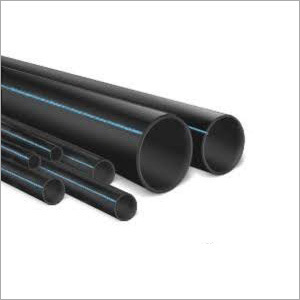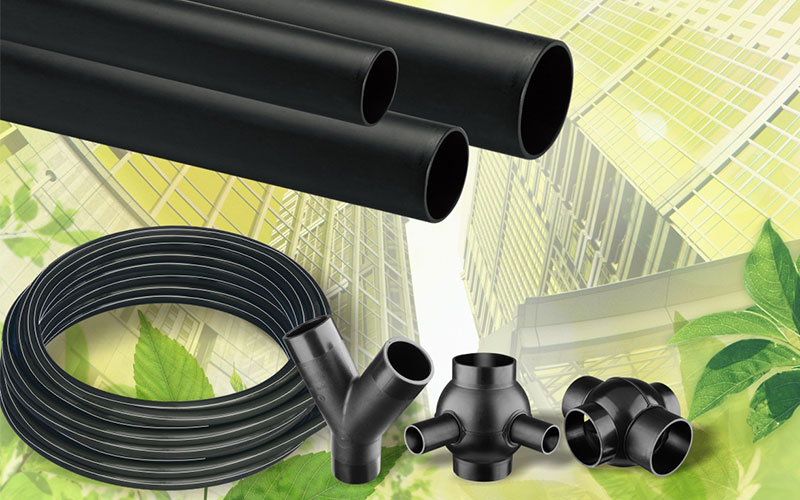Discover the Manufacturing Refine Behind High-Quality HDPE Pipeline and Its Applications
The production procedure of top notch HDPE pipes is elaborate and methodical. It begins with the option of raw materials that enhance performance. Following this, ethylene goes through polymerization to create material, which is then formed with extrusion. Quality assurance is vital, making sure that the last item fulfills rigid requirements. However, the trip of HDPE pipes does not finish with manufacturing. Their applications throughout various sectors expose a broader importance worth analyzing.
Recognizing HDPE: Residences and Advantages

High-density polyethylene (HDPE) is a versatile thermoplastic understood for its durability and resistance to different environmental factors. This material displays exceptional tensile strength, making it appropriate for demanding applications. Its low-density framework adds to a light-weight product, helping with simplicity of dealing with and installment. HDPE also showcases amazing resistance to chemicals, which reduces degradation when revealed to harsh materials.
The material's low wetness absorption further boosts its durability, making it ideal for usage in pipes and storage space tanks. In addition, HDPE is resistant to ultraviolet (UV) radiation, guaranteeing that products maintain their integrity also when exposed to sunshine. Its versatility permits for the creation of detailed shapes without jeopardizing strength. The environmentally friendly nature of HDPE, usually originated from recycled products, adds to its appeal, advertising sustainable techniques in production. Generally, these properties and benefits make HDPE a preferred selection for numerous commercial and consumer applications.
Resources Selection for HDPE Production
The choice of basic materials for HDPE production is important to validate the last item satisfies the wanted specs and top quality requirements. High-density polyethylene (HDPE) is primarily created from polymerized ethylene, stemmed from nonrenewable fuel sources such as gas or petroleum. The quality of these feedstocks greatly influences the mechanical and thermal residential properties of the final HDPE.
Ingredients likewise play a considerable role in boosting HDPE's performance, including antioxidants, UV stabilizers, and colorants, which enhance longevity and resistance to environmental elements. The option procedure have to take into consideration not only the chemical composition of the raw products yet also their handling features to assure reliable production.
The sourcing of raw products need to prioritize sustainability and conformity with environmental policies, as responsible methods are necessary in today's market. Eventually, careful resources option lays the structure for generating high-grade HDPE pipelines suitable for diverse applications.
The Extrusion Process: Forming HDPE Pipeline
The extrusion procedure plays a crucial duty in shaping HDPE pipelines, beginning with thorough product preparation strategies that ensure ideal flow and consistency. Similarly essential is the layout of the die, which directly influences the last dimensions and surface top quality of the pipe. Together, these aspects contribute significantly to the effectiveness and top quality of HDPE pipe manufacturing.
Material Preparation Techniques
Efficient production of HDPE pipelines starts with meticulous product prep work strategies, particularly the extrusion process. Throughout this stage, high-density polyethylene material is first dried to eliminate wetness, guaranteeing suitable circulation characteristics. The resin is after that fed right into the extruder, where it undergoes home heating and melting, transforming right into a viscous state. This heating process is meticulously regulated to preserve the product's honesty and performance. The liquified HDPE is forced through a die, shaping it into a continual pipeline form. Proper temperature administration during extrusion is important, as it straight impacts the material's residential or commercial properties and the end product quality. As soon as formed, the HDPE pipe is cooled down and cut to specified lengths, all set for succeeding handling and applications.
Die Layout Significance
Accuracy in die layout plays an important duty in the extrusion process of HDPE pipes. The die acts as the last shaping tool, directly affecting the pipe's dimensions, wall thickness, and surface area finish. A well-designed die assurances consistent product flow, reducing defects such as abnormalities and weak points. The geometry of the die need to be optimized to accommodate the particular buildings of HDPE, including its viscosity and thermal habits during extrusion. Additionally, the cooling price of the product as it travels through the die can markedly affect the pipeline's architectural honesty. Investing in sophisticated die innovation is important for makers intending to create top notch HDPE pipelines that satisfy industry requirements and client assumptions.
Top Quality Control Actions in HDPE Manufacturing
Although different factors influence the top quality of HDPE pipe production, reliable high quality control steps are vital to guarantee uniformity and reliability in the last item. Trick high quality control methods consist of extensive material examination, confirming that the raw polyethylene fulfills recognized standards for pureness and density. During the extrusion process, criteria such professional sewer camera as temperature, pressure, and cooling time are closely checked to preserve dimensional precision and architectural honesty
In enhancement, post-production screening is necessary; manufacturers commonly perform hydrostatic tests to assess the pipe's strength and resistance to pressure. Aesthetic inspections for surface issues even more improve quality control. Qualification from relevant requirements organizations, like ASTM or ISO, offers an additional layer of reliability. By executing these detailed high quality control steps, suppliers can lessen defects, improve efficiency, and make certain that the HDPE pipes satisfy the certain demands of numerous applications, inevitably causing client satisfaction and count on the item.
Applications of HDPE Pipe Throughout Industries
HDPE pipes are used across different markets as a result of their longevity and versatility. In water circulation systems, they guarantee reliable distribution, while in wastewater monitoring, they offer reliable remedies for waste transport. Additionally, farming irrigation networks gain from HDPE's resistance to deterioration and versatility, making it an optimal choice for modern farming methods.

Water Distribution Systems
A considerable variety of sectors count on high-density polyethylene (HDPE) pipelines for reliable water circulation systems. Understood for their resilience and resistance to rust, HDPE pipelines are widely utilized in local water networks, agricultural irrigation, and industrial applications. Their light-weight nature facilitates easy handling and setup, minimizing labor costs and time. In addition, HDPE pipelines can accommodate different stress levels, making them suitable for both low and high-pressure systems. custom hdpe pipe manufacturing Midland TX. The flexibility of the product enables smooth integration right into existing facilities, decreasing the need for extensive excavation. Moreover, HDPE's resistance to chemical seeping guarantees that the water delivered remains safe and tidy, making it an ideal choice for maintaining the high quality of drinkable water throughout various fields
Wastewater Administration Solutions
Reliable water circulation systems likewise pave the means for ingenious wastewater administration options, where high-density polyethylene (HDPE) pipes play a significant function. Prominent for their longevity and resistance to rust, HDPE pipes are excellent for carrying wastewater in different settings. Their flexibility allows for easy installment in complicated atmospheres, minimizing the need for comprehensive excavation. Furthermore, HDPE's smooth indoor surface decreases rubbing, enhancing flow prices and effectiveness. These pipes are likewise resistant to chemical leaching, making sure that contaminants do not compromise the surrounding setting. Industries, towns, and treatment facilities significantly rely on HDPE pipelines for their dependability and durability, making them a preferred selection for modern wastewater administration systems. This versatility underscores the crucial importance of HDPE pipelines across various applications.
Agricultural Irrigation Networks
Agricultural watering networks benefit significantly from the usage of high-density polyethylene (HDPE) pipelines, which supply efficient and reputable water delivery to crops. HDPE pipes are light-weight, making them very easy to move and set up, while their flexibility permits various arrangements in diverse surfaces. These pipelines demonstrate excellent resistance to deterioration, chemicals, and UV radiation, making certain longevity in rough farming environments. Furthermore, their smooth indoor surface area lessens rubbing loss, optimizing water circulation and minimizing energy costs linked with pumping. The long life of HDPE pipelines, often surpassing 50 years, contributes to decrease maintenance and substitute expenses. Farmers significantly depend on HDPE pipes to improve watering efficiency and promote lasting farming methods, inevitably leading to improved plant returns and resource preservation.

Future Trends in HDPE Pipe Innovation
As the need for sustainable and effective framework expands, innovations in HDPE pipeline innovation are positioned to change different industries. Arising fads consist of the assimilation of wise innovations, such as sensors and IoT capabilities, which help with real-time surveillance of pipe conditions, lowering upkeep expenses and stopping leakages. Additionally, the growth of advanced learn the facts here now manufacturing methods, such as 3D printing, is enabling the production of facility, customized pipe styles that cater to particular job needs.
In addition, the emphasis on recycling and round economy techniques is driving the innovation of HDPE pipelines made from recycled materials, improving sustainability. Boosted jointing approaches, such as electro-fusion and mechanical fittings, are also improving installment performance and dependability. Finally, the expanding focus on environmental regulations is pushing suppliers to adopt greener production processes, ensuring that HDPE pipelines not just satisfy market requirements yet additionally cultivate a more lasting future for facilities growth.
Regularly Asked Inquiries
Exactly How Does HDPE Compare to Various Other Plastic Materials?
HDPE outperforms many other plastic products concerning resilience, chemical resistance, and versatility. Its reduced thickness and high tensile toughness make it perfect for different applications, often exceeding options in both performance and longevity.
What Are the Environmental Influences of HDPE Production?
The environmental impacts of HDPE manufacturing consist of greenhouse gas exhausts, power usage, and potential air pollution from making procedures. In addition, incorrect disposal can cause soil and water contamination, raising worries about long-lasting environmental results.
Can HDPE Pipes Be Recycled?
Yes, HDPE pipes can be reused. Many facilities accept made use of HDPE for processing, transforming it right into new items. This recycling adds to sustainability initiatives, lowering plastic waste while saving sources and power in the production cycle.
What Is the Lifespan of HDPE Pipes?

Exactly How Do Temperature Variations Affect HDPE Pipeline Performance?
Temperature level variants considerably influence HDPE pipeline efficiency, influencing flexibility and strength. Heats can lead to softening, while low temperature levels may cause brittleness, inevitably influencing the pipe's resilience and viability for various applications in varied settings.